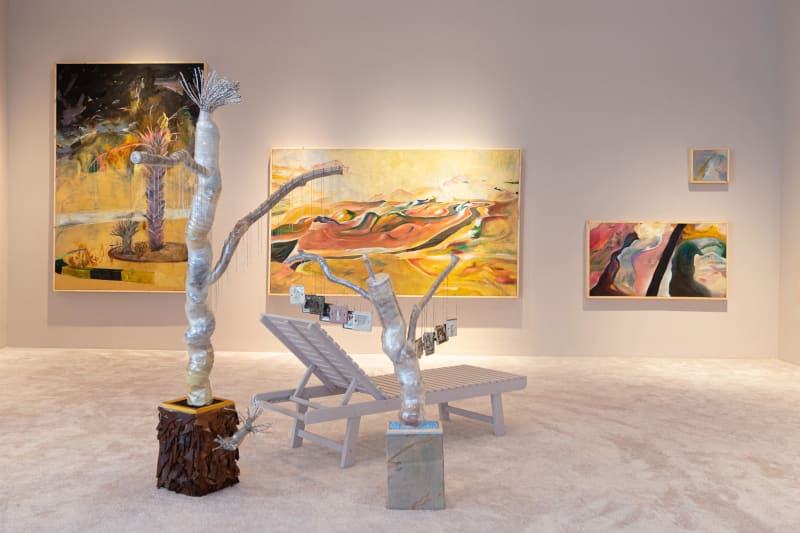Sensu Lato is a newly produced body of work that comprises several works on canvas as well as mixed media pieces inspired by Al Lamki’s lifelong relationship with and ongoing research into the Jebel Hafeet Mountain in Al Ain, UAE. Translating from Latin to English, Sensu Lato means ‘in the broad sense' and in the context of Jebel Hafeet, it denotes the mountain’s connection to the parent range, the Al Hajar Mountains. The exhibition's title also refers to the broad and multifaceted bond that Al Lamki shares with Jebel Hafeet.
Born and raised in Al Ain, Al Lamki felt the presence of the mountain where ever he ventured in the city. Al Ain’s sandy-toned, low rise buildings reveal the face of the mountain from every angle making it a reference point for the surrounding community who used it to gauge the passing of time. Throughout the day sunlight filters between the mountain’s folds, altering the ambience and aesthetic absorbed by the city's inhabitants. The time between noon and twilight remains the most captivating for the artist, his time of tranquillity. Al Lamki captures this dream-like moment with a highly saturated, sensual palette. In Sensu Lato Al Lamki approaches the mountain through multiple lenses - the ecological, the social, and the psychological. Over the years the position of the mountain has altered following tectonic shifts, it moves 5cm north year-upon-year, a process that the artist relates to shifts in human, animal and plant migration patterns to and from the mountain. Several of Al Lamki’s paintings meditate upon the shifts in the mountain’s biodiversity and fauna while other pieces consider the relationship between mankind and the mountain.
A preoccupation with the relationship between man and land echoes throughout Al Lamki’s practice. Here, he considers the shifting relationship between man and mountain over time and the materialisation of human imposition upon nature. The artist depicts the monumental four-wheel-drive vehicles synonymous with the region stationed on the new roads that wrap around the mountain. He shares glimpses into the material traces of the newly opened hotels and cafes that have been introduced to Jebel Hafeet, ushering in a new era of human connection to this space. In one work, the artist’s depiction of an aquarium found in a hotel lobby on Jebel Hafeet reveals contemplation on the curation of nature and the transformation of the natural world into commodities, culture and entertainment.
Central to this work is the process. Transcending the notion of making work ‘on’ the landscape, Al Lamki works within the landscape, absorbing his materials and processes from the environment which surrounds him. In his youth was inspired by the craftwork and dying process of the local artisans from the Bedouin community that surrounded him in Al Ain. Al Lamki was particularly fascinated by their use of natural pigments, sourced from the surrounding land in order to establish natural colours to transform their craftwork. Al Lamki refuses the separation of man and nature, his practice underscores the dependency of mankind on natural resources and their subsequent responsibility for the environmental catastrophe that looms. His approach to art fuses social innovation, sustainability, environmental consciousness.
Inspired by scientific methodologies and local artisanal processes, Al Lamki’s palette comprises freshly formed pigments derived from natural resources in the MENA region. Through this process of alchemy, Al Lamki articulates the fragility and scarcity of these elements as well as their immense natural powers.

